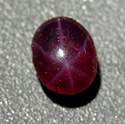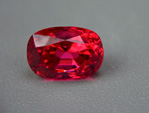
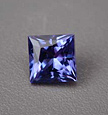
Spinel, especially in its red and blue color varieties, is a historically important gem. Because it was often found with corundum in gem deposits and has a similar color range, luster and hardness, it was, until modern times, used unknowingly as sapphire, and especially ruby. The famous "Black Prince's Ruby" which forms part of the Crown Jewels of England, is, in fact, a red spinel. The advent of modern gemological identification and separation techniques in the later 19th century established spinel as a distinct species.


In another essay I referred to malachite as the "Rodney Dangerfield" of gemstones, but perhaps that description is even more apt for spinel. Early in the 20th century soon after Auguste Verneuil invented the flame fusion process for making synthetic sapphire, synthetic spinel was made by the same method. For many years, if the public was aware of spinel at all, it was as an imitation found in birthstone jewelry and high school class rings. It's true that the synthetic stuff is as common as dirt, and almost as cheap, but fine natural spinel is, and has always been, a rare gem. Only recently, as the level of gemological awareness of consumers has begun to rise has spinel finally been "getting some respect". This increased appreciation stems not only from the gem's inherent rarity and beauty, but also from the fact that virtually all spinels in today's market are unenhanced. As more information comes to light about the extensive and invasive treatments given to lower grade ruby and sapphire to "pump up" their color or clarity, spinel's natural beauty, and still relatively modest prices, become ever more inviting.
Found traditionally in Burma (Myanmar) and Sri Lanka (Ceylon), and more recently from various sites in Vietnam, Africa, Russia, and Australia, spinel is usually mined not from the hard rock primary deposits in which it forms, but from alluvial or placer deposits where eroded material has been washed down stream. These "gem gravels" may consist of several different species in addition to spinel, but have in common that the rolling and tumbling action has smoothed the rough crystals into rounded shapes, and in the process removed much of the included and fractured parts of the gem rough. Such alluvial rough makes good faceting material -- well shaped for recovery and relatively clean. Mining methods range from primitive to low technology (from one or more miners and with their straw baskets sluicing the stream gravel, to the use of backhoes and hydraulic hoses for removing overburden from long buried streambeds, and supplying larger amounts of water for gem separation by a small crew).
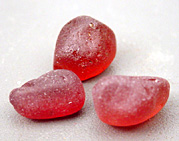
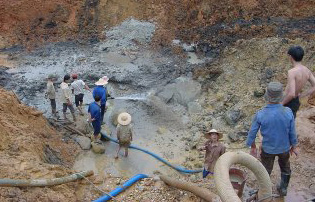
When spinel is found at the site of formation (often in metamorphic rock deposits) one of its most beautiful crystal "habits" is that of the octahedron. You may know that diamonds also naturally occur in this form, which is one shown only by gems belonging to the cubic crystal system. In my eyes a blazing red spinel octahedron is one of Nature's most beautiful productions.
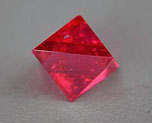
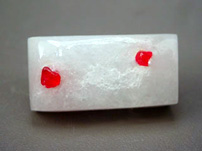
Spinel is an example of an "allochromatic" gemstone. This means that when the mineral, in this case (MgAl2O4) is pure, it is colorless -- various colors are dervived only from the presence of trace elements acting as chromophores, for spinel these would most commonly be chromium, iron and cobalt. The majority of jewelry gems fall into this category: corundum (sapphire and ruby), topaz, quartz and beryl for example all have colorless varieties which are those formed without the color-making "impurities".
For the majority of the allochromatic gems the colorless type is the most common, and therefore the least valuable. Compare for example the value of the finest quality 5 carat emerald (green beryl) with a equivalently fine 5 carat Goshenite (colorless beryl). Those tiny trace amounts of chromium or vanadium that give the emerald its vibrant green bring the price up at least 100 fold compared to the pure beryl mineral. A similiar illustration could be made of ruby vs white sapphire or amethyst vs rock crystal quartz. Spinel is an exception to this pattern. Until quite recently no colorless spinel had been found in Nature. Lab production was easily possible (colorless spinel can be made by the bucketful), but apparently the conditions under which this gem forms in Nature rarely exclude the coloring trace elements, making the colorless natural stone a rare and valuable collector gem! And spinel does, indeed, form in many colors: ranging throughout all shades of pink, lavender, red, red-orange, purple, blue and even black. The only part of the spectrum that seems to be omitted is the pure green and yellow.


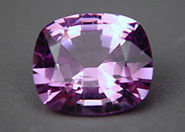
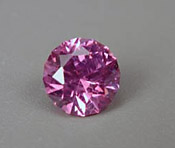
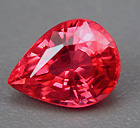
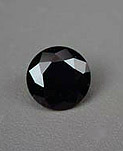
By far the most common colors, and therefore those lowest in value, are pale to medium mauve-pink and greyish light purples. (I have a gardener friend who once described this pink-mauve color as "Garden of Eden" because left to their own devices, most of her fancy colored hybrid flowers would self-sew and grow into "wild types" of precisely this color.) The color (and therefore value) difference between the two spinel ring stones below is mainly that of "saturation". This term doesn't, as is often thought, mean deepness or darkness, but refers instead to absense of grey and brown tones, that is, the spectral purity of a color. In the world of gem pricing, saturation is the main player. You could easily expect to pay 5 to 10 times as much per carat for the true red one on the right as for the less saturated pink one on the left.
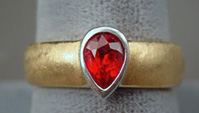
In the purple and blue hues, spinel is most often a relatively steely or greyish color or quite dark in tone, either of which depresses the price. At present, even though popularity is beginning to rise, spinel is still a great gem bargain. I hope this happy situation continues, but quite honestly, my advice is to buy spinel now, before the rest of the gem consuming public really catches on, and prices go through the roof.
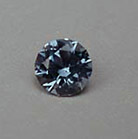
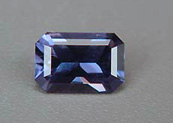
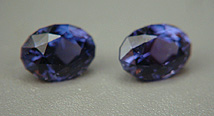
Regardless of color, spinel's high refractive index insures excellent brilliance in a well cut and polished stone, and its hardness of 8 makes it a good choice for almost all jewelry applications -- rings included. I still wouldn't recommend it for a high "Tiffany-type" setting in a engagement or signature ring that will be worn 24/7 for years, but for any less demanding use, it is a wonderful gem. No special cleaning or care instructions apply.
The majority of the spinel jewelry for sale today is in the pink and red color range. I expect this to change as the variously colored African spinels make more of an impact on the market. Black spinel, by the way, makes a less expensive substitute for black diamond and a more durable, if more expensive, alternate for black onyx. Spinel beads are relatively rare in the marketplace, but sometimes sold by vendors who specialize in higher grade goods.
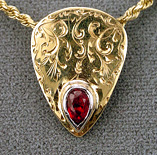
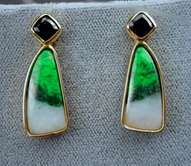
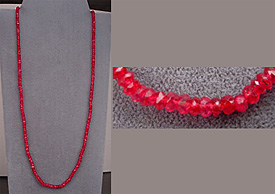
The most highly valued spinels are the reds with purplish red (ruby spinels) and orangey red (known as flame spinels) colors, commanding the premium prices. Top quality red spinels are actually rarer than top quality rubies, although they are not as expensive. Burmese provenance in fine stones always adds value.
As with all stones, values are highest for rich, saturated colors in clean stones and large sizes. Pink spinels in hues from bubblegum color to hot pinks are sought after. The blues and violets, unless the color is highly saturated are, in general, more modestly priced. Among the blue stones, those colored by cobalt are especially valued for their pure, rich color. Star stones and color change varieties are rare in this species and highly valued. Spinels can generally be assumed, at present, to be unenhanced, although gemologists are keeping close watch for new developments along this line.
